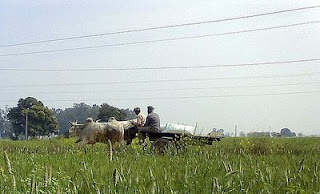
India’s Punjab region faces a host of troubles: In the last 10 years, 100,000 of India’s desperate farmers—many of them Punjabi—have been
driven to suicide by their inability to repay loans; half a century of heavy fertilizer use in Punjab has led to soaring cancer rates; water tables in the region sink as much as 100 feet per year, the result of decades of rice production in a naturally dry area; overwatering has brought salts to the soil’s surface, making large tracts of land unusable; and by some accounts, 40 percent of Punjab’s youth and nearly half of its agricultural workforce are addicted to heroin.
In a series of reports from Punjab published in Slate magazine, Mira Kamdar argues that the economic, security, and environmental problems facing India can ultimately be traced back some 40 years to the policies of the Green Revolution. The drive to feed India’s rapidly growing population put enormous pressure on Punjab’s land and left consideration for sustainability on the back burner, according to Kamdar, who argues that these issues now threaten to paralyze India’s agricultural sector.
The Green Revolution alleviated the chronic famines that historically plagued India. Hybrid seed varieties, extensive irrigation schemes, and the heavy-handed use of chemical fertilizers and pesticides transformed Punjab into an agricultural powerhouse. It comprises only 1.5 percent of India’s territory, but it produces 60 percent of the country’s wheat and 45 percent of its rice. Yet Kamdar wonders whether India will be able to “feed a growing population in the face of environmental collapse and growing political instability fueled by scarcity.”
With little hope for economic stability, Punjab’s youth are increasingly turning to the drug trade for income, and Punjab’s impoverished citizens, many of whom feel exploited and left behind by the Indian government, are attractive recruits for separatist groups. “Conditions affecting the livelihood of the majority of people in poor countries [or regions] are at the heart of the internal violence” so often found there, according to a report from the International Peace Research Institute (PRIO).
Due to the effects of climate change, the 400 million additional people projected to live in India by 2080 may have to make do with a nearly 40 percent decline in agricultural production during the same period, according to the Peterson Institute for International Economics. Current policies will do little to alleviate the pressures colliding in Punjab. The government—as well as the World Bank, international agriculture corporations, and Indian companies—favors privately funded, large-scale industrial operations. Palaniappan Chidambaram, India’s minister of finance, is focused on developing India’s agricultural capacity, and is not terribly concerned with the consequences for the environment, security, or human health. Small-scale farming is quickly becoming a thing of the past.
Many countries face the challenge of feeding a growing population with diminishing output, and find doing so in an ecologically responsible manner difficult. Ultimately, though, the case of India shows that increasing output at such dramatic cost to human and environmental health is unsustainable, as it quickly creates complex and intractable problems of its own.
Photo: Punjabi farmers transport fertilizer from a nearby village. Courtesy of Flickr user Aman Tur.
 India’s Punjab region faces a host of troubles: In the last 10 years, 100,000 of India’s desperate farmers—many of them Punjabi—have been driven to suicide by their inability to repay loans; half a century of heavy fertilizer use in Punjab has led to soaring cancer rates; water tables in the region sink as much as 100 feet per year, the result of decades of rice production in a naturally dry area; overwatering has brought salts to the soil’s surface, making large tracts of land unusable; and by some accounts, 40 percent of Punjab’s youth and nearly half of its agricultural workforce are addicted to heroin. In a series of reports from Punjab published in Slate magazine, Mira Kamdar argues that the economic, security, and environmental problems facing India can ultimately be traced back some 40 years to the policies of the Green Revolution. The drive to feed India’s rapidly growing population put enormous pressure on Punjab’s land and left consideration for sustainability on the back burner, according to Kamdar, who argues that these issues now threaten to paralyze India’s agricultural sector.
India’s Punjab region faces a host of troubles: In the last 10 years, 100,000 of India’s desperate farmers—many of them Punjabi—have been driven to suicide by their inability to repay loans; half a century of heavy fertilizer use in Punjab has led to soaring cancer rates; water tables in the region sink as much as 100 feet per year, the result of decades of rice production in a naturally dry area; overwatering has brought salts to the soil’s surface, making large tracts of land unusable; and by some accounts, 40 percent of Punjab’s youth and nearly half of its agricultural workforce are addicted to heroin. In a series of reports from Punjab published in Slate magazine, Mira Kamdar argues that the economic, security, and environmental problems facing India can ultimately be traced back some 40 years to the policies of the Green Revolution. The drive to feed India’s rapidly growing population put enormous pressure on Punjab’s land and left consideration for sustainability on the back burner, according to Kamdar, who argues that these issues now threaten to paralyze India’s agricultural sector. A Publication of the Stimson Center.
A Publication of the Stimson Center.

 India’s Punjab region faces a host of troubles: In the last 10 years, 100,000 of India’s desperate farmers—many of them Punjabi—have been
India’s Punjab region faces a host of troubles: In the last 10 years, 100,000 of India’s desperate farmers—many of them Punjabi—have been 

